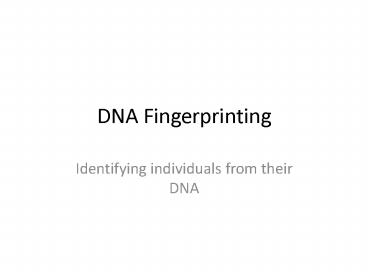DNA Fingerprinting - PowerPoint PPT Presentation
1 / 15
Title:
DNA Fingerprinting
Description:
DNA Fingerprinting Identifying individuals from their DNA Starter Rearrange the pictures to show the sequence of DNA fingerprinting Cell sample DNA comparison Binding ... – PowerPoint PPT presentation
Number of Views:196
Avg rating:3.0/5.0
Title: DNA Fingerprinting
1
DNA Fingerprinting
- Identifying individuals from their DNA
2
StarterRearrange the pictures to show the
sequence ofDNA fingerprinting
Cleavage of DNA by restriction enzyme
DNA comparison
Cell sample
X ray film Used to detect radioactive DNA pattern
Separation of DNA fragments by electrolysis
Binding of radioactive DNA probe
Transfer to nylon Membrane (Southern Blot)
Membrane washed to remove excess probe
Extracted DNA
3
Genetic fingerprinting process
- Extraction and digestion of DNA with restriction
enzymes - Separation of DNA fragments and southern blotting
- Hybridisation of DNA probes to nylon membrane
- Development of membrane with
- x-ray film
TASK In 4 groups you are going to represent the
key stages of the process in a series of diagrams
with detailed explanations
4
(No Transcript)
5
16.8 Genetic fingerprinting
- 10.1 Coordination.
6
- Learning outcomes
- Success criteria
- By the end of this lesson I will know
- What genetic fingerprinting is
- How genetic fingerprinting is carried out and the
results interpreted - What genetic fingerprinting is used for
- By the end of this lesson I can
- Describe the theory behind genetic fingerprinting
- Produce a flow diagram of the key stages in the
process - Make a concept map to summarise the uses of
genetic fingerprinting - Answer exam questions about genetic
fingerprinting
7
Genetic fingerprinting - background
95 of the human genome consists of INTRONS
(non-coding DNA)
E1
E2
Intron
CORE SEQUENCE Repetitive DNA sequence within
intron
- Individuals have a unique pattern of core
sequences in their DNA - The number of different core sequences varies
between individuals and... - The length of each core sequence also varies
The more closely related two individuals are the
more similar their core sequences will be e.g.
Identical twins
8
Genetic fingerprinting basics
Because everyones DNA is unique DNA
fingerprinting can be used for identification
1) Isolation DNA is extracted from blood, hair
or semen. Increase the quantity using PCR.
2) Fragmentation the DNA is cut into fragments
using restriction enzymes
3) Separation the DNA sections are separated
using electrophoresis
4) Comparison the DNA is compared to a sample
from the crime scene
9
Genetic fingerprinting process
- Extraction and digestion of DNA with restriction
enzymes - Separation of DNA fragments and southern blotting
- Hybridisation of DNA probes to nylon membrane
- Development of membrane with
- x-ray film
TASK In 4 groups you are going to represent the
key stages of the process in a series of diagrams
with detailed explanations
10
DNA Fingerprinting the process
Extraction
Digestion
Separation
Hybridisation
Development
11
DNA Fingerprinting the process
Extraction
Digestion
Separation
Hybridisation
Development
12
Summary questions
- Answer summary questions 1 and 2 from page 278 of
the textbook - Answers
- Very small amounts of DNA may be gathered from a
crime scene so PCR is used to increase the
quantity available for analysis - (a) suspect B was present since genetic
fingerprint matches that of the blood - (b) The victims DNA fingerprint rules out the
possibility of blood found having come from them
13
Uses of genetic fingerprinting
- Make a concept map to summarise and explain these
different uses of genetic fingerprinting
Paternity tests
Identify criminals
Testing genetic variability in a population
Genetic fingerprinting
Medical diagnosis of disease
Selective breeding of plants and animals
Identify microbes
- Refer to information on pages 277-279 of the
textbook to help you
14
Plenary / Homework
- Read through the application of genetic
fingerprinting on pages 278-279 and answer the
application questions
15
- Learning outcomes
- Success criteria
- By the end of this lesson I will know
- What genetic fingerprinting is
- How genetic fingerprinting is carried out and the
results interpreted - What genetic fingerprinting is used for
- By the end of this lesson I can
- Describe the theory behind genetic fingerprinting
- Produce a flow diagram of the key stages in the
process - Make a concept map to summarise the uses of
genetic fingerprinting - Answer application style questions about genetic
fingerprinting































